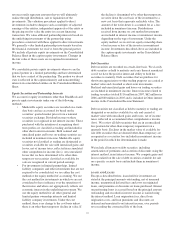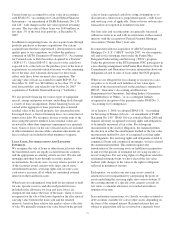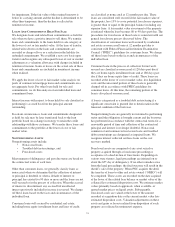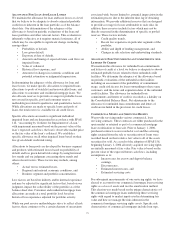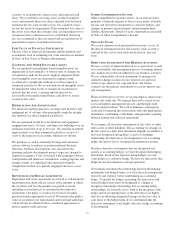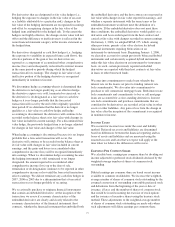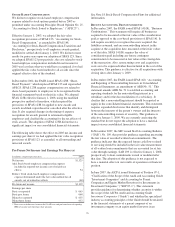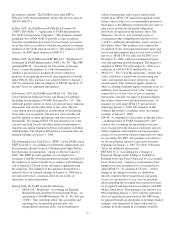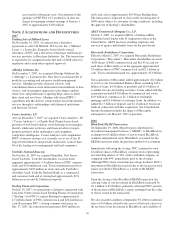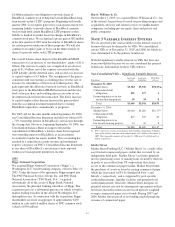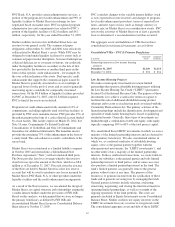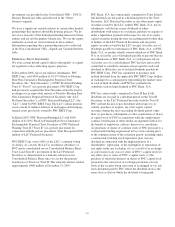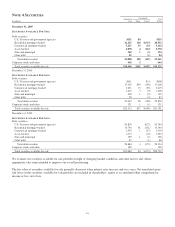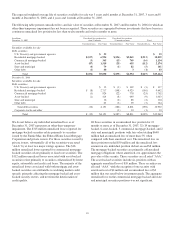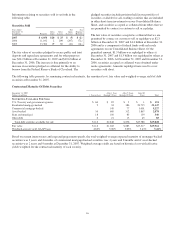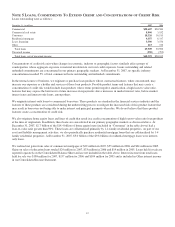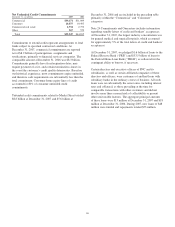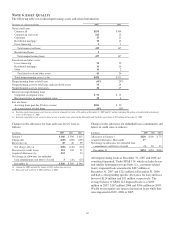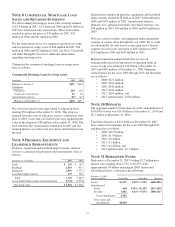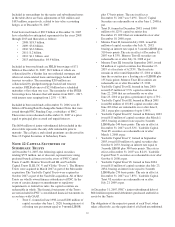PNC Bank 2007 Annual Report Download - page 87
Download and view the complete annual report
Please find page 87 of the 2007 PNC Bank annual report below. You can navigate through the pages in the report by either clicking on the pages listed below, or by using the keyword search tool below to find specific information within the annual report.
PNC Bank, N.A. provides certain administrative services, a
portion of the program-level credit enhancement and 99% of
liquidity facilities to Market Street in exchange for fees
negotiated based on market rates. PNC recognized program
administrator fees and commitments fees related to PNC’s
portion of the liquidity facilities of $12.6 million and $4.1
million, respectively, for the year ended December 31, 2007.
Neither creditors nor investors in Market Street have any
recourse to our general credit. The commercial paper
obligations at December 31, 2007 and 2006 were effectively
collateralized by Market Street’s assets. While PNC may be
obligated to fund under liquidity facilities for events such as
commercial paper market disruptions, borrower bankruptcies,
collateral deficiencies or covenant violations, our credit risk
under the liquidity facilities is secondary to the risk of first
loss provided by the borrower or another third party in the
form of deal-specific credit enhancement – for example, by
the over collateralization of the assets. Deal-specific credit
enhancement that supports the commercial paper issued by
Market Street is generally structured to cover a multiple of
expected losses for the pool of assets and is sized to generally
meet rating agency standards for comparably structured
transactions. Of the $8.8 billion of liquidity facilities provided
by PNC at December 31, 2007, only $2.8 billion required
PNC to fund if the assets are in default.
Program-level credit enhancement in the amount of 10% of
commitments, excluding explicitly rated AAA/Aaa facilities, is
provided by PNC and a monoline insurer. PNC provides 25% of
the enhancement in the form of a cash collateral account funded
by a loan facility. This facility expires on March 23, 2012. See
Note 5 Loans, Commitments To Extend Credit and
Concentrations of Credit Risk and Note 24 Commitments and
Guarantees for additional information. The monoline insurer
provides the remaining 75% of the enhancement in the form of
a surety bond. The cash collateral account is subordinate to the
surety bond.
Market Street was restructured as a limited liability company
in October 2005 and entered into a Subordinated Note
Purchase Agreement (“Note”) with an unrelated third party.
The Note provides first loss coverage whereby the investor
absorbs losses up to the amount of the Note, which was $8.6
million as of December 31, 2007. Proceeds from the issuance
of the Note are held by Market Street in a first loss reserve
account that will be used to reimburse any losses incurred by
Market Street, PNC Bank, N.A. or other providers under the
liquidity facilities and the credit enhancement arrangements.
As a result of the Note issuance, we reevaluated the design of
Market Street, its capital structure and relationships among the
variable interest holders under the provisions of FIN 46R.
Based on this analysis, we determined that we were no longer
the primary beneficiary as defined by FIN 46R and
deconsolidated Market Street from our Consolidated Balance
Sheet effective October 17, 2005.
PNC considers changes to the variable interest holders (such
as new expected loss note investors and changes to program-
level credit enhancement providers), terms of expected loss
notes, and new types of risks (such as foreign currency or
interest rate) in Market Street as reconsideration events. PNC
reviews the activities of Market Street on at least a quarterly
basis to determine if a reconsideration event has occurred.
The aggregate assets and liabilities of VIEs that we have
consolidated in our financial statements are as follows:
Consolidated VIEs – PNC Is Primary Beneficiary
In millions
Aggregate
Assets
Aggregate
Liabilities
Partnership interests in low income housing
projects
December 31, 2007 $1,110 $1,110
December 31, 2006 $ 834 $ 834
Low Income Housing Projects
We make certain equity investments in various limited
partnerships that sponsor affordable housing projects utilizing
the Low Income Housing Tax Credit (“LIHTC”) pursuant to
Section 42 of the Internal Revenue Code. The purpose of these
investments is to achieve a satisfactory return on capital, to
facilitate the sale of additional affordable housing product
offerings and to assist us in achieving goals associated with the
Community Reinvestment Act. The primary activities of the
limited partnerships include the identification, development and
operation of multi-family housing that is leased to qualifying
residential tenants. Generally, these types of investments are
funded through a combination of debt and equity, with equity
typically comprising 30% to 60% of the total project capital.
We consolidated those LIHTC investments in which we own a
majority of the limited partnership interests and are deemed to
be the primary beneficiary. We also consolidated entities in
which we, as a national syndicator of affordable housing
equity, serve as the general partner (together with the
aforementioned investments, the “LIHTC investments”), and
no other entity owns a majority of the limited partnership
interests. In these syndication transactions, we create funds in
which our subsidiary is the general partner and sells limited
partnership interests to third parties, and in some cases may
also purchase a limited partnership interest in the fund. The
fund’s limited partners can generally remove the general
partner without cause at any time. The purpose of this
business is to generate income from the syndication of these
funds and to generate servicing fees by managing the funds.
General partner activities include selecting, evaluating,
structuring, negotiating, and closing the fund investments in
operating limited partnerships, as well as oversight of the
ongoing operations of the fund portfolio. The assets are
primarily included in Equity Investments on our Consolidated
Balance Sheet. Neither creditors nor equity investors in the
LIHTC investments have any recourse to our general credit.
The consolidated aggregate assets and debt of these LIHTC
82


